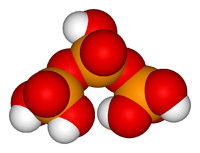Triphosphoric acid
 | |
 | |
| Names | |
|---|---|
| IUPAC name
Diphosphono hydrogen phosphate | |
| Identifiers | |
| 10380-08-2 | |
| ECHA InfoCard | 100.030.752 |
| UNII | NU43IAG5BC |
| |
| Properties | |
| H5P3O10 | |
| Molar mass | 257.95 g/mol |
| Acidity (pKa) | small, small, 2.30, 6.50, 9.24 |
| Hazards | |
| Main hazards | Corrosive (C) |
| Except where otherwise noted, data are given for materials in their standard state (at 25 °C [77 °F], 100 kPa). | |
| | |
| Infobox references | |
Triphosphoric acid (also tripolyphosphoric acid), with formula H5P3O10, is a condensed form of phosphoric acid. In the family of phosphoric acids, it is the next polyphosphoric acid after pyrophosphoric acid, H4P2O7, also called diphosphoric acid.
Compounds such as ATP (adenosine triphosphate) are esters of triphosphoric acid.
Triphosphoric acid has not been obtained in crystalline form. The equilibrium mixture with an overall composition corresponding to H5P3O10 contains about 18% of triphosphoric acid. A solution of the pure species can be obtained by ion exchange of the sodium salt, sodium triphosphate, at 0 °C.[1]
Various pKa values are reported, 1.0 ; 2.2 ; 2.3 ; 5.7 ; 8.5,[1] 1.0 ; 2.2 ; 2.3 ; 3.7 ; 8.5 [2]
References
- 1 2 Corbridge, D. (1995). "Chapter 3: Phosphates". Studies in inorganic Chemistry vol. 20. Elsevier Science B.V. pp. 169–305. ISBN 0-444-89307-5. Retrieved January 30, 2015. – via ScienceDirect (Subscription may be required or content may be available in libraries.)
- ↑ Holleman, A. F.; Wiberg, E. (2001), Inorganic Chemistry, San Diego: Academic Press, p. 729, ISBN 0-12-352651-5
This article is issued from Wikipedia - version of the 8/4/2016. The text is available under the Creative Commons Attribution/Share Alike but additional terms may apply for the media files.